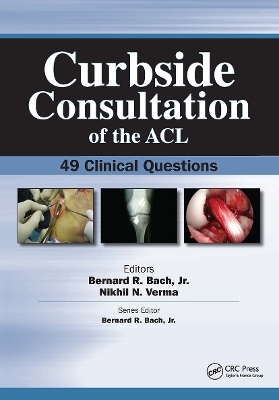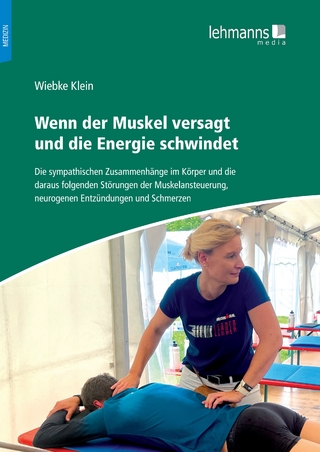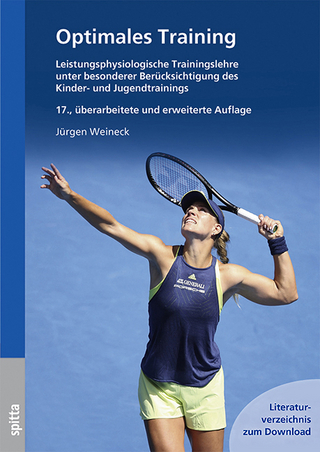
Curbside Consultation of the ACL
SLACK Incorporated (Verlag)
978-1-55642-825-8 (ISBN)
Drs. Bernard R. Bach, Jr. and Nikhil N. Verma have designed this unique reference which offers expert advice, preferences, and opinions on tough clinical questions commonly associated with ACL management. The unique Q&A format provides quick access to current information related to ACL management with the simplicity of a conversation between two colleagues. Numerous images, diagrams, and references are included to enhance the text and to illustrate the management of ACL issues.
Curbside Consultation of the ACL: 49 Clinical Questions provides information basic enough for residents while also incorporating expert advice that even high-volume clinicians will appreciate. Practicing orthopedic surgeons, orthopedic residents and medical students will benefit from the user-friendly and casual format and the expert advice contained within.
Some of the questions that are answered:
How do you evaluate the failed ACL reconstruction?
What tricks do you have to avoid creation of a “vertical” tunnel when drilling a transtibial tunnel?
How do you evaluate, manage, and prevent motion problems?
How do you determine tibial tunnel position to optimize graft length and femoral tunnel position when performing an endoscopic technique?
How do you manage the expanded femoral or tibial tunnel in a failed ACL patient?
How do you manage the adolescent with open growth plates who has sustained an ACL injury?
Bernard R. Bach, Jr., MD, graduated form Harvard College in 1975, the University of Cincinnati College of Medicine in 1979, and obtained general surgery and orthopaedic training at the New England Deaconess Hospital (1979 to 1981) and Combined Harvard Orthopedic Residency program (1981 to 1985) respectively. He completed a Sports Medicine and Shoulder Fellowship at the Hospital for Special Surgery in 1986. At RUSH University Medical Center in Chicago, Bach is currently the Claude N. Lambert-Helen S. Thomson Professor of Orthopaedic Surgery, the director of the Division of Sports Medicine, and has been the RUSH Sports Medicine Fellowship director since 1988. Dr. Bach has published over 400 peer-reviewed manuscripts, abstracts, books, chapters, guest edited monographs, and internet publications. He has served as president of the Harvard Quigley Sports Medicine Society (2003), the Herodicus Society (2005 to 2006), and the American Orthopedic Society for Sports Medicine (2007 to 2008). He is a member of the Illinois Athletic Trainers’ Hall of Fame and has served on the board of directors for the Illinois Special Olympics, the Orthopedic Research and Education Foundation, and the American Orthopedic Society for Sports Medicine. Dr. Bach assists with the care of professional athletes as one of the team physicians for the Chicago White Sox and Chicago Bulls. Nikhil N. Verma, MD, graduated form the University of Michigan in 1994, the University of Pennsylvania School of Medicine in 1998, and completed his surgical internship and orthopedic residency at Rush University Medical Center (1998 to 2003). He completed a Sports Medicine and Shoulder Fellowship at the Hospital for Special Surgery in 2004 before returning to join the staff of the Department of Orthopedics, Section of Sports Medicine, at Rush University Medical Center as an assistant professor. Dr. Verma currently serves as a member of the American Orthopaedic Society for Sports Medicine self-assessment committee and is a member of the editorial board for the Arthroscopy journal. He has coauthored multiple technique and review articles, book chapters, and peer-reviewed manuscripts in the field of sports medicine. Additionally, he has served as a faculty member for both national and international courses in arthroscopic surgery of the shoulder, elbow, and knee. He serves as head orthopedic team physician for the Chicago Bandits and Chicago Force as well as multiple high school teams in the Chicago metro area. Dr. Verma assists with the care of professional athletes as one of the team physicians for the Chicago White Sox and Chicago Bulls.
CONTENTS Dedication Acknowledgments About the Editors Contributing Authors Preface Foreword William A. Grana, MD, MPH Section I Preoperative Questions Question 1 What Are the Indications for Surgical or Nonsurgical Treatment? Bernard R. Bach, Jr., MD, and Matthew Busam, MD Question 2 What Are the Radiographic, Magnetic Resonance, and KT-1000 Characteristics of an ACL-Injured Knee? Matthew Busam, MD, and Bernard R. Bach, Jr., MD Question 3 How Do You Manage a Combined ACL/MCL Injury? Anne E. Colton, MD, and Charles A. Bush-Joseph, MD Question 4 How Do You Manage a Combined ACL/LCL Injury? Anne E. Colton, MD, and Charles A. Bush-Joseph, MD Question 5 What Determines Which Graft You Recommend for ACL Surgery? Anne E. Colton, MD, and Charles A. Bush-Joseph, MD Question 6 When Would You Use Patellar Tendon Autograft as Your Main Graft Selection? John-Paul H. Rue, MD, LCDR, MC, USN, and Brian J. Cole, MD, MBA Question 7 When Would You Use Hamstring Autograft as Your Main Graft Source? Matthew T. Provencher, MD, LCDR, MC, USN, and Nikhil N. Verma, MD Question 8 When Do You Use Allograft Tissues for Primary ACL Surgery? Warren R. Dunn, MD, MPH Question 9 After an Acute ACL Injury in a Competitive Athlete, How Do You Manage the Patient in Preparation for Surgery? Anne E. Colton, MD, and Charles A. Bush-Joseph, MD Question 10 What Options Are Available in the Patient Who Has a Tibial Eminence Fracture Avulsion (Skeletally Mature, Middle-Aged Patient) Anne E. Colton, MD, and Charles A. Bush-Joseph, MD Question 11 Do You Prefer Endoscopic or 2-Incision Technique and Why? James L. Carey, MD, and Kurt P. Spindler, MD Question 12 How Do You Examine the Knee for Posterolateral Corner Injury Combined With ACL Injury? Luke S. Oh, MD, and Thomas L. Wickiewicz, MD Section II Intraoperative Questions Question 13 What Do You Do if You Drop the Graft on the Floor? Matthew Busam, MD, and Bernard R. Bach, Jr., MD Question 14 How Do You Manage a Posterior Wall Blowout Created Inadvertently at the Time of Surgery? Matthew T. Provencher, MD, LCDR, MC, USN, and Nikhil N. Verma, MD Question 15 How Do You Manage the Hamstring Autograft That Is Prematurely Amputated During Graft Harvest? Robert H. Brophy, MD, and Riley J. Williams, III, MD Question 16 How Would You Manage the Situation of Graft Amputation During Interference Screw Placement With a Patellar Tendon Graft? Brian Kerr, MD, and Eric C. McCarty, MD Question 17 What Tricks Do You Have to Avoid Creation of a Vertical Tunnel When Drilling a Transtibial Tunnel? Luke S. Oh, MD, and Thomas L. Wickiewicz, MD Question 18 What Options Do You Have and How Do You Manage a Construct Mismatch With the Endoscopic Technique? Matthew T. Provencher, MD, LCDR, MC, USN, and Nikhil N. Verma, MD Question 19 What Is Your Preferred Fixation Method for Soft-Tissue Grafts on Both Tibial and Femoral Sides? Seth C. Gamradt, MD, and Riley J. Williams, III, MD Question 20 How Do You Determine Tibial Tunnel Position to Optimize Graft Length and Femoral Tunnel Position When Performing an Endoscopic Technique? Answorth A. Allen, MD Section III Postoperative Questions Question 21 How Do You Manage the ACL Patient Following Reconstruction? John-Paul H. Rue, MD, LCDR, MC, USN, and Brian J. Cole, MD, MBA Question 22 Do You Rehab Your Patellar Tendon Autograft and Allograft Patients Differently? John-Paul H. Rue, MD, LCDR, MC, USN, and Brian J. Cole, MD, MBA Question 23 Do You Manage the Patient Differently if a Concurrent Meniscal Repair Was Performed? John-Paul H. Rue, MD, LCDR, MC, USN, and Brian J. Cole, MD, MBA Question 24 How Do You Manage the Patient Who Is Having a Difficult Time Gaining Extension After Reconstruction? Eric C. McCarty, MD, and Brian Kerr, MD Question 25 How Do You Manage the Patient Who Develops a Postoperative Infection Following ACL Reconstruction? Matthew T. Provencher, MD, LCDR, MC, USN, and Nikhil N. Verma, MD Question 26 How Do You Manage the Patient Who Has Postoperative Patellar Pain? James D. Ferrari, MD Question 27 How Do You Determine the Timing of Reoperation in a Patient Who Has Motion Problems Following an ACL Reconstruction? James D. Ferrari, MD Question 28 What Criteria Do You Use to Return an Athlete to Sport? John-Paul H. Rue, MD, LCDR, MC, USN, and Brian J. Cole, MD, MBA Question 29 What Are Your Expected Results After ACL Reconstruction? Jerome J. DaSilva, MD, and Nikhil N. Verma, MD Question 30 Is There Any Significant Difference When Comparing the Results of Various Grafts in Your Practice? R. Edward Glenn, Jr., MD Question 31 What Is the Role of Bracing After ACL Reconstruction, Both in the Postoperative Setting and With Return to Competition? James L. Carey, MD, and Kurt P. Spindler, MD Section IV Failed ACL Reconstruction Questions Question 32 What Are the Causes of ACL Reconstruction Failure? Kyle R. Flik, MD Question 33 What Are the Indications for Revision ACL Surgery? Shane J. Nho, MD, MS; Michael Pensak, BS; and John D. MacGillivray, MD Question 34 How Do You Manage the Expanded Femoral or Tibial Tunnel in a Failed ACL Patient? Luke S. Oh, MD, and Thomas L. Wickiewicz, MD Question 35 What Grafts Do You Use for Revision ACL Reconstruction? Scott A. Rodeo, MD Question 36 When Do You Use the Contralateral Patellar Tendon for Revision ACL Reconstruction? Nicholas T. Dutcheshen, MD, and Thomas J. Gill, MD Question 37 Is Your Rehabilitation Protocol Different in First Time Versus Revision ACL Patients? Shane J. Nho, MD, MS; Michael Pensak, BS; and John D. MacGillivray, MD Question 38 Does Hardware Have to Routinely Be Removed at the Time of Revision ACL Surgery? R. Edward Glenn, Jr., MD Question 39 How Do You Manage the Patient Who Has Early Degenerative Joint Disease and Has Complaints of Pain and Instability? Annunziato Amendola, MD Question 40 If You Have a Patient Who Is a Candidate for a High Tibial Osteotomy and ACL Reconstruction, Should You Perform a 1-Stage or 2-Stage Procedure? Annunziato Amendola, MD Question 41 What Technical Pearls Do You Have When Performing a Single-Stage ACL Reconstruction and High Tibial Osteotomy? Annunziato Amendola, MD Question 42 How Do You Manage the Postoperative Patellar Fracture Following ACL Reconstruction With Patellar Tendon Autograft? Matthew Busam, MD, and Bernard R. Bach, Jr., MD Question 43 How Do You Evaluate Tunnel Position in the Revision Setting? L. Pearce McCarty, III, MD, and Aimee S. Klapach, MD Section V Pediatric/Adolescent Questions Question 44 How Do You Manage the Adolescent With Open Growth Plates Who Has Sustained an ACL Injury? 173 Stephen F. Brockmeier, MD, and Riley J. Williams, III, MD Question 45 What Surgical Options Are Available in the Adolescent With Considerable Growth Remaining? Aimee S. Klapach, MD, and L. Pearce McCarty, III, MD Question 46 My Daughter Is a High School Basketball Athlete. What Are the Risks of Tearing Her ACL? If She Has That Knee Fixed, What Are the Risks for the Opposite Knee? Are There ACL Injury Prevention Programs Available? Nicholas T. Dutcheshen, MD, and Thomas J. Gill, MD Section VI Miscellaneous Questions Question 47 What Is Your Preferred Nonoperative Treatment Protocol for Acute ACL Injuries in Patients Who Do Not Wish to Undergo Surgery? Kyle R. Flik, MD Question 48 What Are the Long-Term Implications of the Patient With Recurrent Instability in the Setting of Untreated ACL Injuries? Scott A. Rodeo, MD Question 49 What Implications Does ACL Reconstruction Have on the Future Development of Degenerative Arthritis? Kurt P. Spindler, MD, and James L. Carey, MD Index
| Erscheint lt. Verlag | 30.4.2008 |
|---|---|
| Reihe/Serie | Curbside Consultation in Orthopedics |
| Sprache | englisch |
| Maße | 178 x 254 mm |
| Gewicht | 400 g |
| Themenwelt | Medizin / Pharmazie ► Medizinische Fachgebiete ► Sportmedizin |
| ISBN-10 | 1-55642-825-1 / 1556428251 |
| ISBN-13 | 978-1-55642-825-8 / 9781556428258 |
| Zustand | Neuware |
| Haben Sie eine Frage zum Produkt? |
aus dem Bereich


